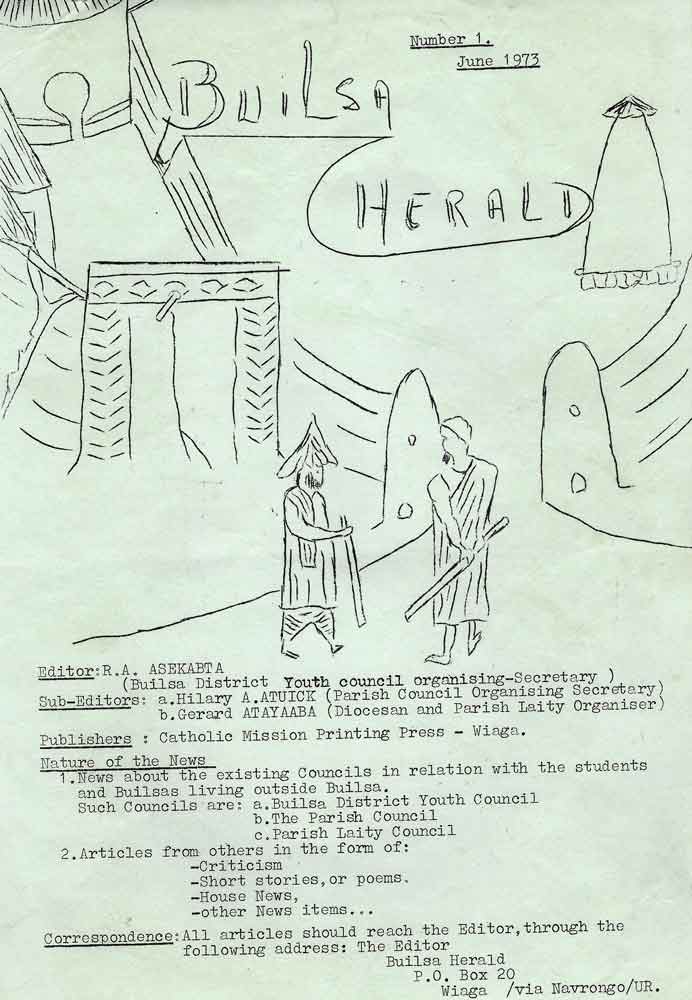 Bulsa Herald (1973-74)
Bulsa Herald (1973-74)Franz Kröger
History of Bulsa Journals
When the number of educated young Bulsa whose interest went far beyond the concerns of their own homestead and village increased, they also developed a growing demand for written information about political, social and religious events. Moreover, there was a strong urge to keep in contact with students and other Bulsa living outside of Buluk. In the 1970s there were no newspapers and, apart from smaller collections of books in schools, no central libraries in the District. Therefore, journals also quenched the younger generation’s thirst for reading material from all fields. Although particular attention is given to the facts and problems of modern life in the first magazines, themes having to do with traditional culture (customs, proverbs, stories, etc.) are not completely lacking. Initially, the young Bulsa editors and authors needed some financial and technical assistance for their journalistic work, and they initially found this in the Christian missions. The first issues were reproduced by stencil printing in small editions and sold for a very low price.
 Bulsa Herald (1973-74)
Bulsa Herald (1973-74)
Three copies of this first Bulsa journal (June and October 1973 and February 1974) were published by the Catholic Mission (Wiaga). The chief editor was Robert Asekabta (Youth Council Organising Secretary), and the assistant editors were Hilary Atuick (Parish Council Organising Secretary) and Gerard Atayaaba (Diocesan and Parish Laity Organizer).
The cover page depicts the drawing of a traditional compound in front of which a man with a leather hat (the herald) is transmitting news to another man, probably the house owner.
The journal contains parish news, reviews about different Catholic organizations, letters to
the editors, personal information about other educated persons (e.g. teachers, visitors to
Bulsaland) as well as poems and short stories. One noteworthy essay is a longer piece by a
“Parish Research Committee” on Bulsa marriage traditions (no. 2 and 3). This piece stresses
the particular concern about the incorporation of traditional rites into the liturgy of the
Catholic Church.

The Star (1978)
In 1978, when Mrs. Claire Gray gave elementary English lessons to Bulsa children in the Presbyterian Mission at Sandema, the demand for reading material and provisional school books gave rise to the founding of a journal called The Star. A. Adams, the editor, worked in co-operation with Claire and Ian Gray, the GILLBT Bible translators. In addition to pieces of general information, the journal contains short stories, riddles and proverbs in Buli and English.
Sampan-na / Sampana
(Talking-Drums, 1993-96?)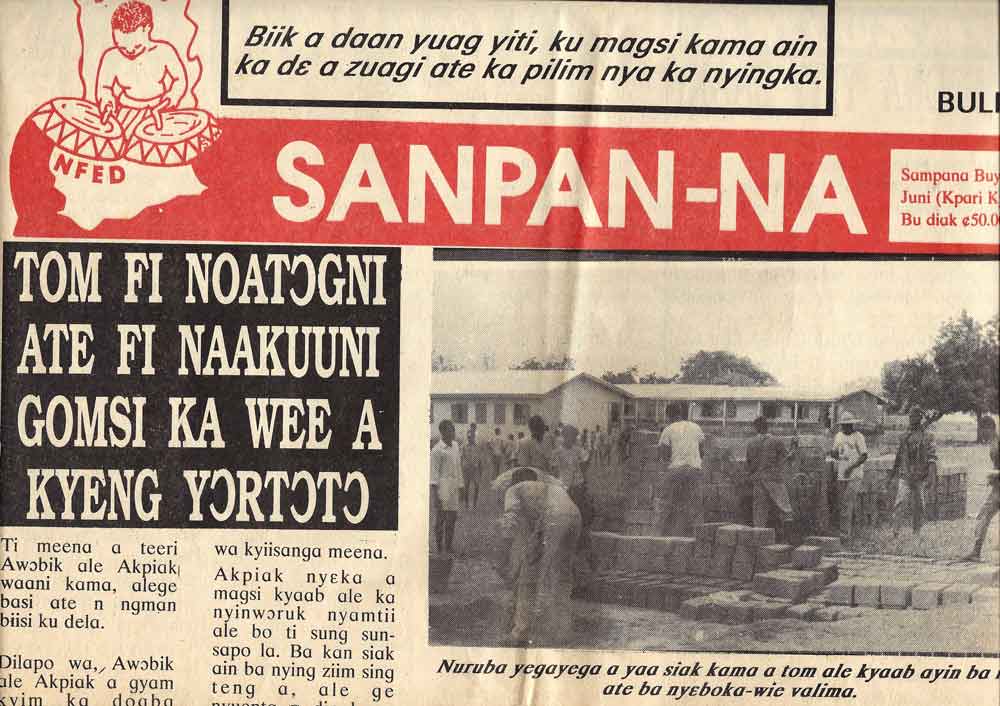
When this journal in newspaper format appeared as a printed issue with black-and-white photos, it certainly represented a great leap forward in the history of Bulsa magazines. The editorial board consisted of Bulsa (e.g. Dr. George Akan-lig-Paare, now a senior lecturer in Linguistics at the University of Ghana, Legon, and Anyabadek Apentiik from Bilinsa (now Dr. Caesar Apentiik, lecturer in Archaeology at the University of Calgary, Canada) and non-Bulsa alike. The whole paper was edited in Buli.
Only the following issues are in my possession: no. 7 (June 1993), no. 11 (December 1994) and no. 5 (new series? August 1996). It is still unknown how many issues appeared altogether and within which exact period of time.
The subjects dealt with in the articles are manifold: news on education, politics, health and economics as well as traditional Bulsa stories. Not all articles refer to Bulsa affairs; several of them inform the reader about events and problems in modern Ghana.
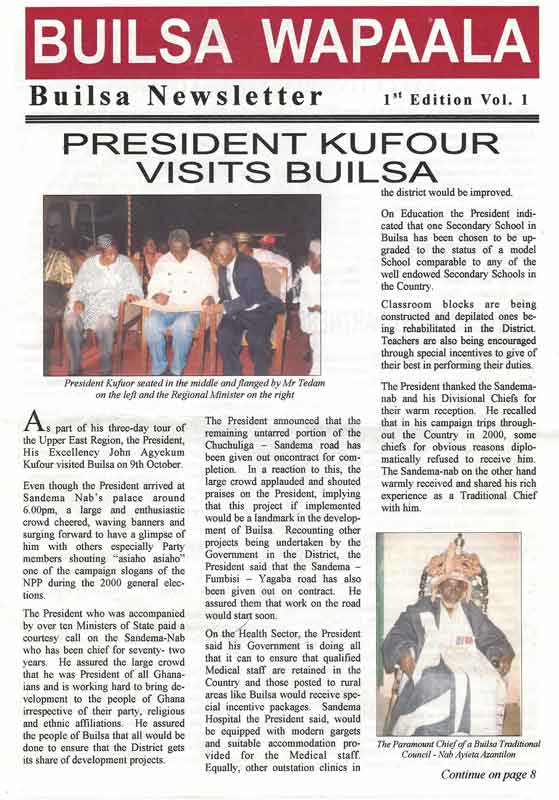
Bulsa Wapaala (2002)
When in 2001 Pastor James Agalic became DCE (District Chief Executive) of the Bulsa District, he initiated a journal called Bulsa Wapaala (Bulsa News). The editorial board consisted of the following members: Rev. James Agalic (chairman), Dramani Mahama (senior editor), Timothy Ataboadey A. (editor) and Alfred Sawuug (member). The paper was designed and printed by the GILLBT Press (Tamale). In the first issue (and I do not know whether there were any more), the main emphasis is placed on politics in the Bulsa District. The articles deal, for example, with the following subjects: President John Agyekum Kufuor’s visit in the Bulsa District, new development projects (dams, streetlights, electricity), the new District Assembly (with the names of all members) as well as a collection of proverbs in Buli and English.
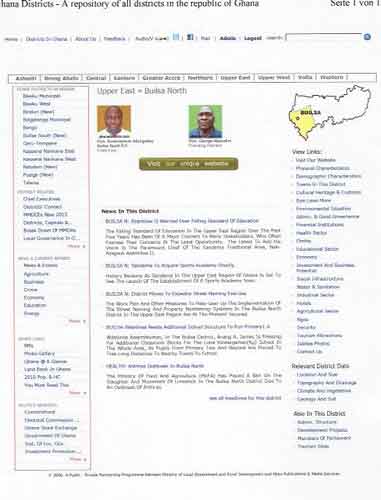
Websites of the Bulsa Districts (See Review in BULUK 5: 20)
In the early years of the new millennium, a Ghanaian website was launched which comprised all districts of the country in sub-domains. The homepages of the Bulsa District – and since 2011 the two Bulsa Districts – are probably organized by officials of the district administration or members of the Assembly.
The news appears on the first page and is mainly concerned with political affairs. Critics may point out that even the latest news is some years old and that there are no dates associated with the listed events.
The website is, however, very useful in providing basic data about the district: this includes physical and demographic as well as health and educational information, matters concerning the administration of the district, etc.
Buluk, Journal of Bulsa Culture and Society (1999 - present)
In 1999 when Ghanatta Ayaric and I made up our minds to start a
Bulsa journal, we tried to place special consideration on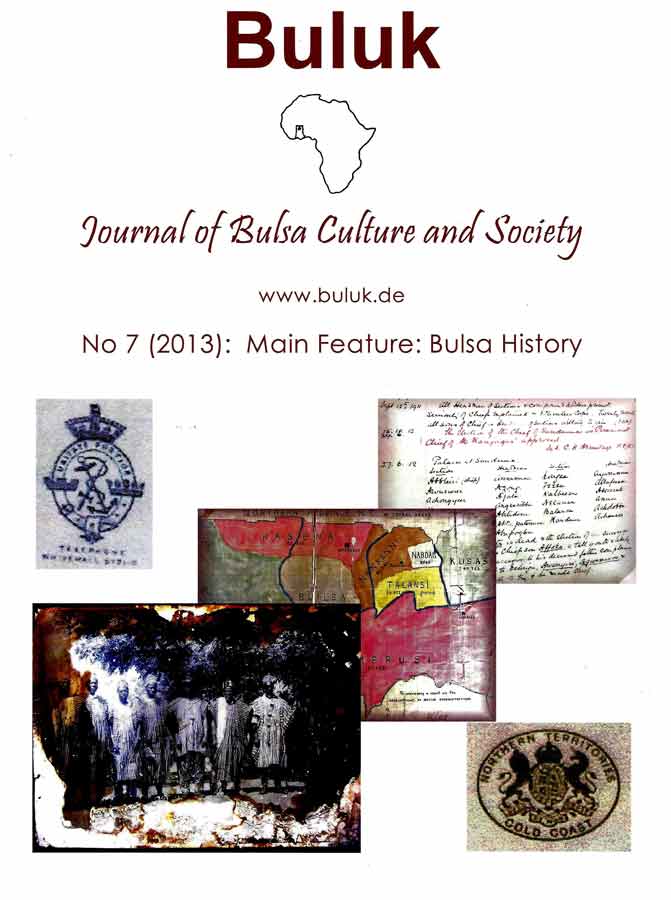 communicating with the Bulsa living in the European diaspora and providing them
with relevant information about events in Ghana.
communicating with the Bulsa living in the European diaspora and providing them
with relevant information about events in Ghana.
BULUK was also supposed to be an organ for smaller literary products (particularly short stories, essays and poems) as well as for smaller research results, notes and data about Bulsa traditional culture.
The first copies of BULUK were very modest in appearance. The first single colour photos appeared in editions 2 and 3. Nevertheless, the first editions resulted in a heavy financial burden for the two editors, particularly when the interest of the Bulsa living in Germany was very limited. Therefore we made up our minds to transform BULUK into an internet journal and to print no more than about 50 hard copies. Hitherto the internet website has had more than 8000 visitors.
The BULUK journal does not consider itself a rival to other journals and internet websites, but it is trying to fill gaps. There has been excellent co-operation with the BMY internet discussion group which, after 2009, replaced our first attempt to form a platform for discussions among Bulsa in a more efficient way. If one day the Bulsa District website feeds its readers with more data on recent events, we will be happy to give up our “events” section to concentrate more on historical and anthropological research, on the products of modern Bulsa authors and poets and on the individual opinions of Bulsa political, social and religious leaders.